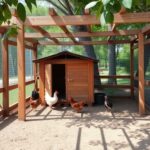If you’re looking to create a cozy home for your feathered friends without breaking the bank, you’ve come to the right place! Here are 19 simple chicken coop DIY ideas that will help you get started on building a functional and charming space for your chickens, all while keeping things easy and fun.
Adding Nesting Boxes for Egg Laying
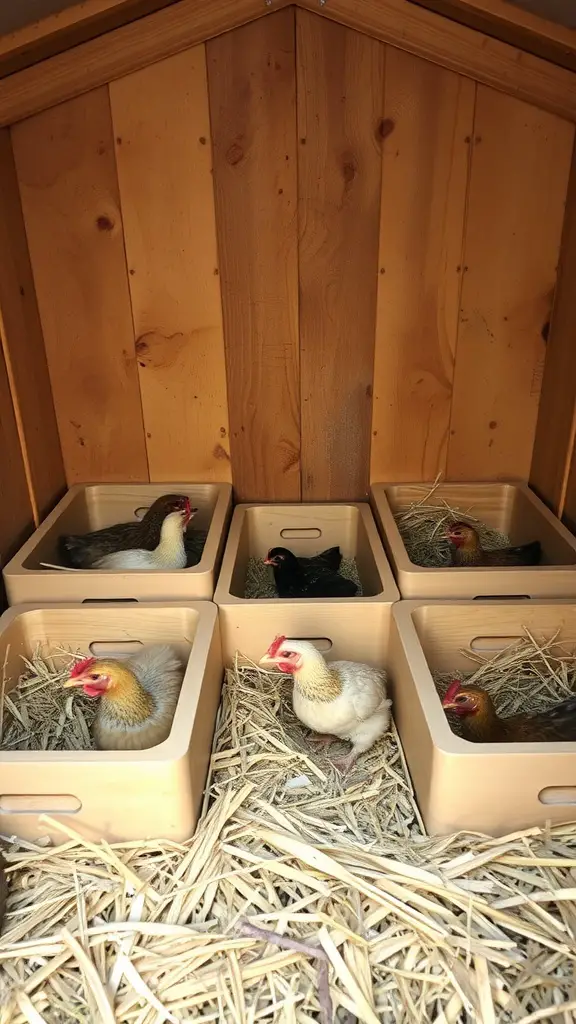
Nesting boxes are essential for a functional chicken coop, especially for egg-laying hens. These cozy spaces offer comfort and privacy, encouraging your chickens to lay their eggs. In the image, you can see a well-structured row of nesting boxes that provides a perfect little nook for each hen.
Using simple containers, like the ones shown, makes it easy to set up nesting boxes. Just ensure they’re clean and filled with fresh straw or hay. This not only keeps the boxes comfy but also helps in keeping the eggs clean.
When placing the boxes, aim for a height that’s easy for the hens to access. Each box can hold one hen at a time, so providing enough boxes is key to avoiding competition among your flock. Ideally, have one box for every three to four hens.
Check the nesting boxes regularly to gather the eggs and ensure they remain clean. Your hens will appreciate the effort, and you’ll enjoy the reward of fresh eggs!
Creating Ventilation for Fresh Air
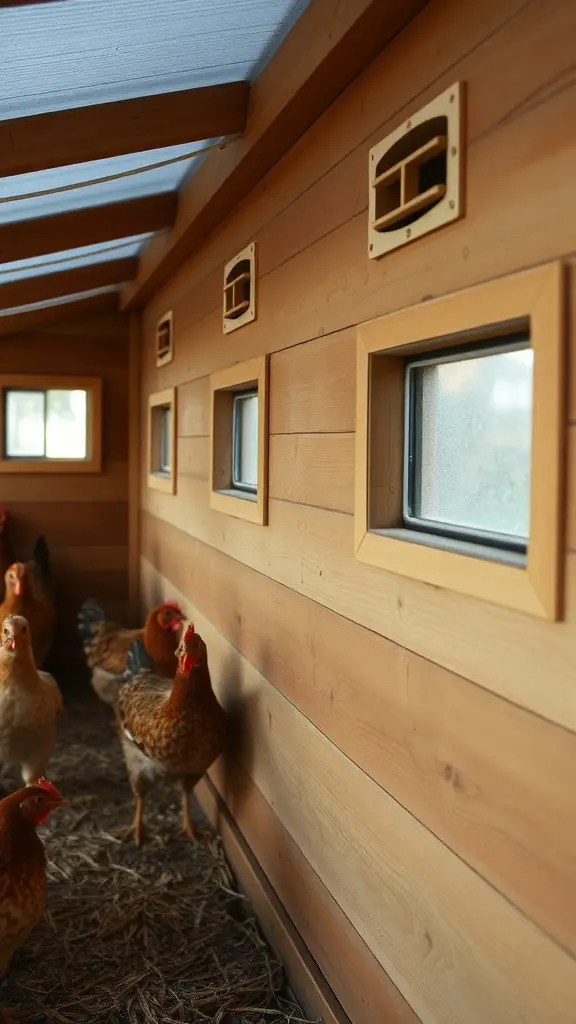
Ventilation is crucial for your chicken coop. It helps manage moisture and keeps the air fresh, which is vital for your chickens’ health.
The image shows a well-designed coop with multiple ventilation openings. These vents allow air to circulate freely while keeping your birds safe from drafts.
Consider installing adjustable vents. This way, you can control the airflow depending on the weather. In hot months, ample ventilation keeps your chickens cool. During colder months, you can reduce airflow to keep them warm.
Position the vents high on the wall. Warm air rises, so placing them up high helps to release the heat while maintaining a comfortable environment inside the coop.
Remember to check the vents regularly. Keeping them clean ensures optimal airflow and prevents any blockages.
Essential Materials for Building a Chicken Coop

When diving into the world of DIY chicken coops, having the right materials is key. The image captures a variety of tools and materials that can play a crucial role in your coop-building journey.
First, you’ll notice a collection of wooden planks and dowels. These will form the main structure of your coop. Choosing quality wood helps ensure durability, which is important for protecting your chickens from the elements.
Next, there are some essential tools like a hammer and clamps. These tools will be your best friends when it comes to assembling the coop. A good set of tools can make the process smoother and more enjoyable.
The presence of screws and nails in the image highlights the importance of secure fastening. You want your coop to be sturdy, especially if you live in an area with strong winds or predators lurking around.
Lastly, don’t forget about the mesh or wire seen in the mix. This is vital for ventilation and keeping your chickens safe. It’s important to select the right gauge to ensure that no unwanted guests can get in.
Choosing the Right Location for Your Chicken Coop

When setting up a chicken coop, location is key. Look at the image above, showcasing a cozy red chicken coop nestled in a well-kept backyard. This spot balances sunlight and shade, which is essential for your feathered friends.
First, consider the sunlight. Chickens enjoy some sun during the day but also need shaded areas to cool off. The large tree in the image offers perfect shade, creating a comfortable environment for the chickens.
Next, think about accessibility. You want to easily reach the coop for daily feeding and cleaning. The layout in this image allows for easy access while keeping the chickens safe. Also, ensure that there are no obstacles like heavy traffic areas nearby that might disturb them.
Additionally, keep an eye on drainage. A dry location helps prevent muddy conditions, which chickens dislike. The well-groomed grass suggests good drainage in the area, making it an ideal spot.
Lastly, consider the proximity to your home. Keeping the coop close can make daily chores more manageable while ensuring the hens are secure. With a little planning, you can provide a welcoming space for your chickens, just like the lovely setup in this picture!
Designing a Functional Coop Layout
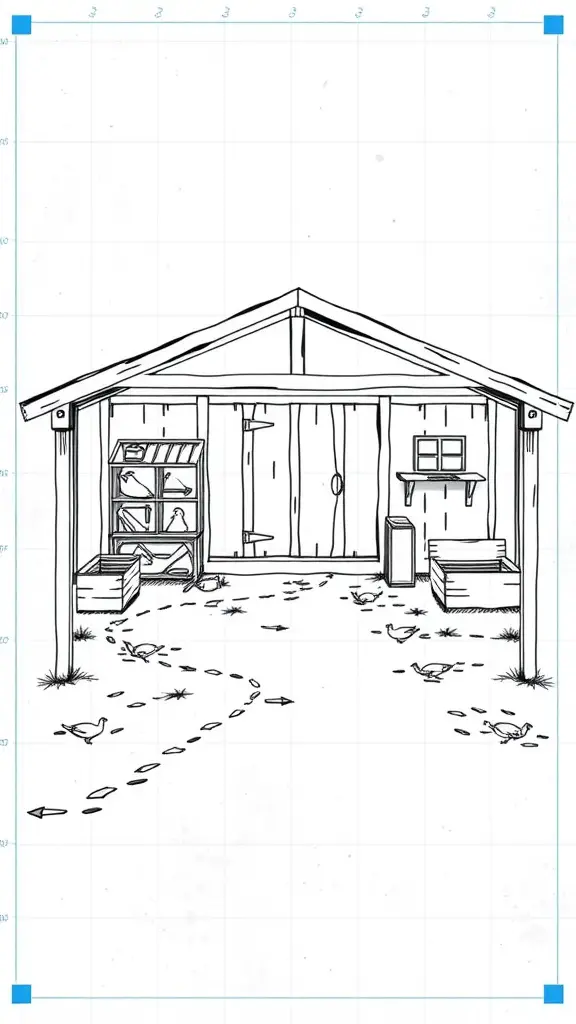
When it comes to creating a chicken coop, layout is everything. The image provides a simple yet effective design to maximize space and functionality. The coop features ample room for your chickens to roam while still keeping things organized and tidy.
The overall structure includes designated areas for nesting boxes, feeding stations, and plenty of walking space. This design helps ensure that your chickens are comfortable and happy. You’ll also notice clear paths, which are crucial for easy access to different sections of the coop.
Consider adding ventilation and natural light to enhance your coop’s environment. The sketch illustrates how to effectively balance these needs while keeping your feathered friends secure and sheltered. A well-thought-out layout can make daily maintenance much easier, allowing you to enjoy your time with your chickens.
As you move forward with your DIY project, think about how your chickens will interact with their space. A functional design will promote their well-being and make your chicken-raising experience enjoyable. Remember, a little planning goes a long way!
Installing Durable Flooring

When building a chicken coop, having the right flooring is essential. The image shows a cozy coop with wooden beams and a soft glow from the sunlight streaming in. The floor appears to be under construction, with some boards laid out and wood shavings scattered around. This setup is a great reminder that a sturdy floor can make a big difference in keeping your chickens happy and healthy.
Choosing the right material is important. You might consider using treated plywood or concrete as they are both easy to clean and resistant to moisture. A solid floor prevents mud and water from seeping in, which helps keep your chickens dry. You can also add a layer of straw or wood shavings on top for comfort and better waste management.
In the image, you can see the beginnings of a wooden floor that will eventually be perfect for your feathery friends. Make sure to secure all the boards tightly, as chickens can be curious and might peck at loose edges. A well-installed floor not only looks good but also ensures a safe environment for your flock.
Remember to plan for drainage if your coop is outdoors. Sloping the floor slightly toward a designated area can help keep things tidy. A little thought put into the flooring will go a long way in maintaining your chicken coop!
Building the Coop Frame

Building the frame of your chicken coop is an exciting step in the DIY process. This image shows a well-structured frame with vertical wooden panels and a sturdy roof. The open design allows for plenty of airflow, which is essential for keeping your chickens comfortable.
As you can see, the frame is made from untreated lumber. This is a good choice as it’s usually more affordable and safe for your birds. Make sure to measure and cut your wood accurately to ensure everything fits together nicely. You don’t want any gaps that could let in predators!
In the center of the coop, there’s a grid laid on the ground. This is likely a base for coop flooring or a run area. Using a grid can help keep the ground clean and provides some drainage. It’s important to think about the flooring to keep pests out and maintain a clean environment for your chickens.
Overall, framing your chicken coop is a straightforward task. Just take it step by step, and soon you’ll have a cozy home for your feathered friends.
Constructing Roosting Perches for Comfort

In your chicken coop, roosting perches are essential for your feathered friends to rest comfortably at night. The image showcases well-built perches that provide a cozy spot for chickens to settle down. These perches are made from sturdy wood and are spaced appropriately to allow for enough room for each bird.
When building these perches, it’s important to consider the height and width. Chickens generally prefer to roost higher up, so placing the perches at a height they can comfortably reach is key. Additionally, the width of the perch should be enough to accommodate their feet without being too wide, as chickens feel secure when they can grasp the perch fully.
As you can see in the image, the perches are slightly slanted. This design helps prevent your chickens from slipping off during the night. Using wood that is smooth and free from splinters will also ensure their comfort. It’s a simple yet effective way to enhance their living conditions.
Don’t forget to provide enough space between the perches to avoid any squabbles. Chickens have their own social hierarchy, and giving them room helps maintain peace among the flock. By creating a comfortable roosting area, you’ll support their well-being and happiness.
Implementing a Feeding System

Creating a practical feeding system is key to keeping your chickens happy and healthy. In the image, you can see several feeding bowls designed to hold a mix of grains, which are essential for chickens’ diets. These bowls are neatly arranged, making it easy for your birds to access their food without too much fuss.
When setting up your feeding system, consider using elevated feeders like the ones shown. They help to minimize waste and keep the feed cleaner. Plus, this design can reduce the chances of pests getting into the food. Regularly check the bowls to ensure they’re filled and clean, which keeps your chickens excited for mealtime.
Mixing different grains can provide a balanced diet for your flock. You might want to include ingredients like corn, oats, and protein pellets. Each ingredient plays a role in their health, so a little variety goes a long way. This way, your chickens will not only be well-fed but also more productive!
Creating an Outdoor Run for Chickens

Building an outdoor run for your chickens is a fun and rewarding project. In the image, you can see a lively group of chickens enjoying their spacious run. They roam freely on a grassy area, which gives them plenty of room to scratch and peck. Along with the chickens, there are cozy shelters where they can take a break from the sun.
When planning your outdoor run, consider the size and materials. A good rule of thumb is to allocate at least 10 square feet per chicken. This ensures they have enough space to thrive. Using sturdy fencing is essential to keep them safe from predators.
In the picture, you can notice the fencing around the run. It’s tall enough to deter any curious animals. Adding a roof can further protect your chickens from aerial threats. Make the environment fun by including perches, dust baths, and even some shade from trees.
A vibrant outdoor run not only keeps your chickens happy but also encourages them to stay active. You’ll love watching their natural behaviors unfold as they explore and socialize. Remember, a well-designed run is the heart of a happy chicken coop!
Using Waterproof Roofing Materials
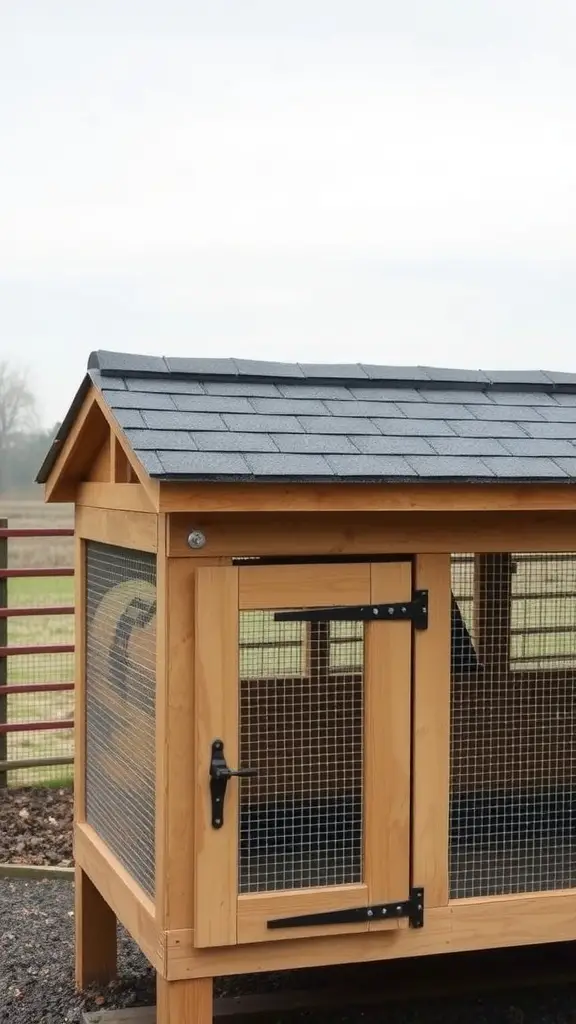
When building a chicken coop, choosing the right roofing material is essential. A waterproof roof keeps your chickens dry and comfortable, especially during rainy weather.
The image shows a well-constructed chicken coop with a sloped roof covered in dark shingles. This type of roofing not only looks nice but also provides excellent protection against the elements.
Using materials like asphalt shingles or metal roofing ensures that water doesn’t seep through. This can save you from future repairs and keep your coop in good shape for years to come.
Additionally, consider installing a slight overhang. This will help direct rainwater away from the coop walls, keeping the structure dry and adding to its durability.
Don’t forget about ventilation, too! Proper airflow is crucial, so make sure your roof design allows for it without compromising waterproofing.
Installing a Chicken Door for Easy Access
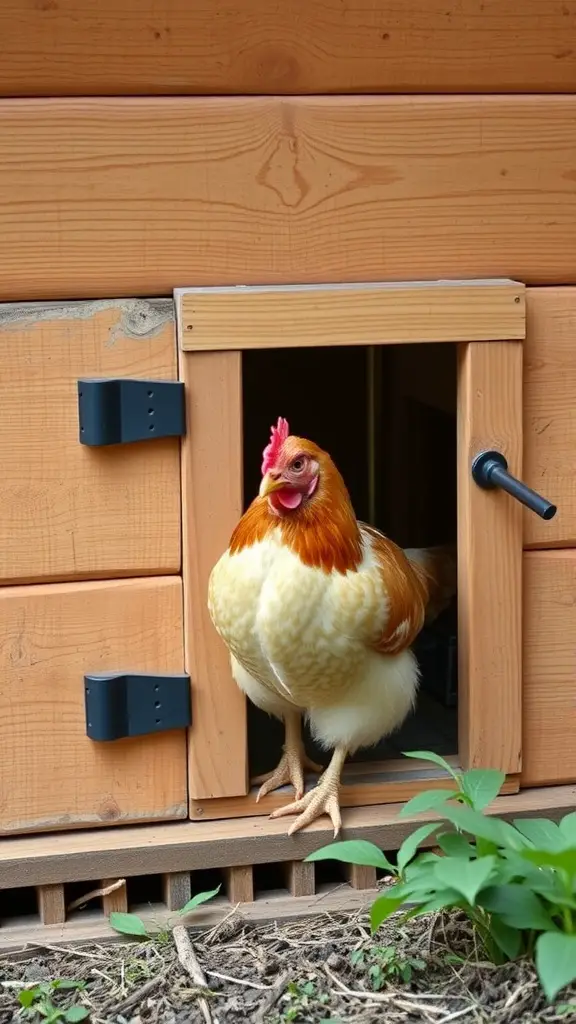
Picture a cozy chicken coop with a small door that’s just perfect for your feathery friends. This is where a chicken door comes into play. It allows chickens to come and go freely, making their lives a lot easier. A well-designed chicken door is a simple yet effective addition to any DIY chicken coop project.
In the image, you can see a chicken peeking out from a small door. This design not only makes it easy for the chickens to access the outside but also adds a charming touch to the coop. The door can be made from basic materials, and installing it is not as complicated as it might seem.
When planning your chicken door, think about size and placement. It should be just big enough for your chickens to fit through comfortably. Also, consider using a latch to keep them secure at night. This way, you can enjoy peace of mind while your chickens are safely tucked away.
Incorporating a chicken door into your coop design is a smart move. It encourages your chickens to explore their outdoor space, which is essential for their health and happiness. Plus, it makes feeding and caring for them much simpler.
Securing the Coop from Predators
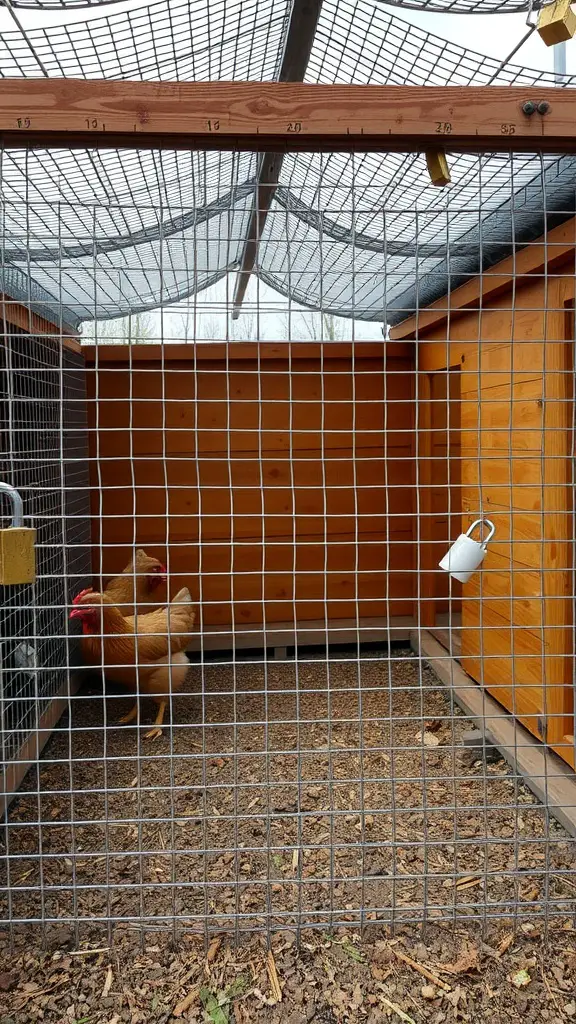
When building a chicken coop, one of the most important things to consider is how to keep your chickens safe from predators. The image above shows a well-constructed coop that incorporates a strong wire mesh for added security. This design helps ensure that unwanted visitors cannot get in, while still allowing your chickens to enjoy the outdoors.
The wire mesh forms a barrier that is tough for most animals to penetrate. It’s crucial to choose a durable, rust-resistant material to withstand the elements. For extra safety, you might also want to cover the top, as many predators can jump or fly over. The coop featured in the image has a covered roof, which is a smart choice.
Additionally, consider the ground around the coop. Digging predators like raccoons or foxes can burrow underneath. To prevent this, you can bury some wire mesh a foot deep around the perimeter. This extra step can provide peace of mind and keep your flock safe.
Don’t forget to secure all doors and windows with sturdy locks. The coop in the image has a lock on the door, which is a simple yet effective measure. Regularly checking these areas will help ensure that your chickens stay safe day and night.
Providing Fresh Water Sources
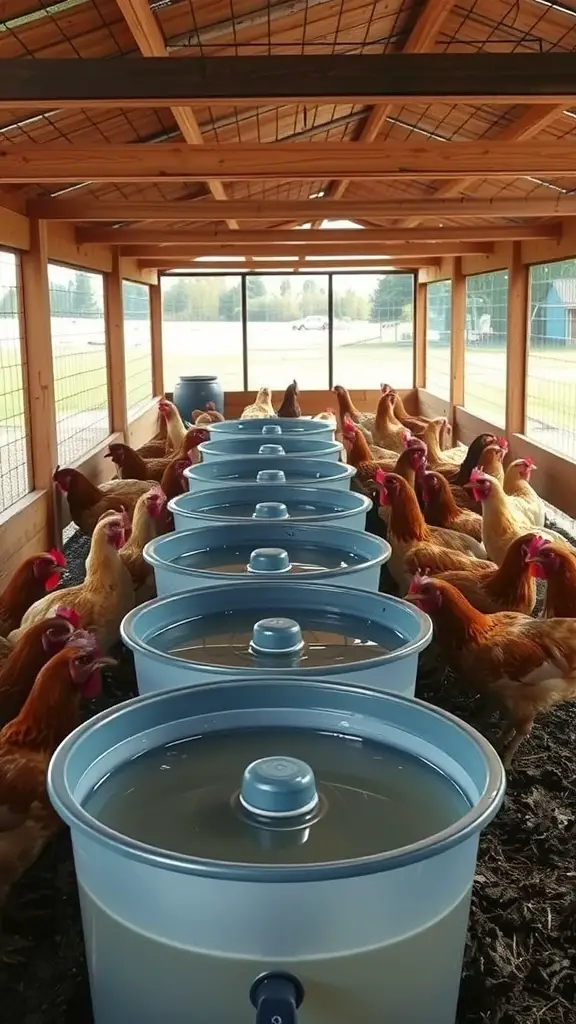
When it comes to raising chickens, providing fresh water is crucial. The image shows a well-organized setup with several water containers placed neatly for the flock. Each container is designed to hold ample water, ensuring that your chickens stay hydrated throughout the day.
Chickens need access to clean water at all times, especially in warm weather. The containers in the photo are elevated, which helps to keep the water clean and prevents contamination from dirt and debris. This simple design allows for easy filling and maintenance.
Consider using large, durable containers to minimize the need for frequent refills. Depending on the number of chickens you have, you may want multiple water sources to avoid overcrowding. Keeping the water fresh is just as important as the quantity; regularly changing the water helps to maintain their health.
In addition to containers, think about installing a water heater in colder months. This will keep the water from freezing, ensuring your chickens can drink whenever they need. All these strategies make it easier to provide your chickens with the hydration they need to thrive.
Incorporating a Cleanout System

When building a chicken coop, one of the key features to consider is a cleanout system. This makes maintaining a tidy environment so much easier. In the image, you can see a simple yet effective cleanout setup. The white container acts as a collection bin for bedding and waste, keeping the area organized and manageable.
Having a designated spot for waste is a smart move. As you can see, the chickens are comfortably roaming around, and this helps ensure their living space stays clean. Regularly removing waste not only helps keep odors down but also promotes a healthier habitat for your flock.
Additionally, the image shows a handy scoop tool hanging nearby. This is perfect for quickly gathering up waste and making cleanouts a breeze. With the right tools and setup, you can spend less time cleaning and more time enjoying your chickens.
Decorating the Coop for Style
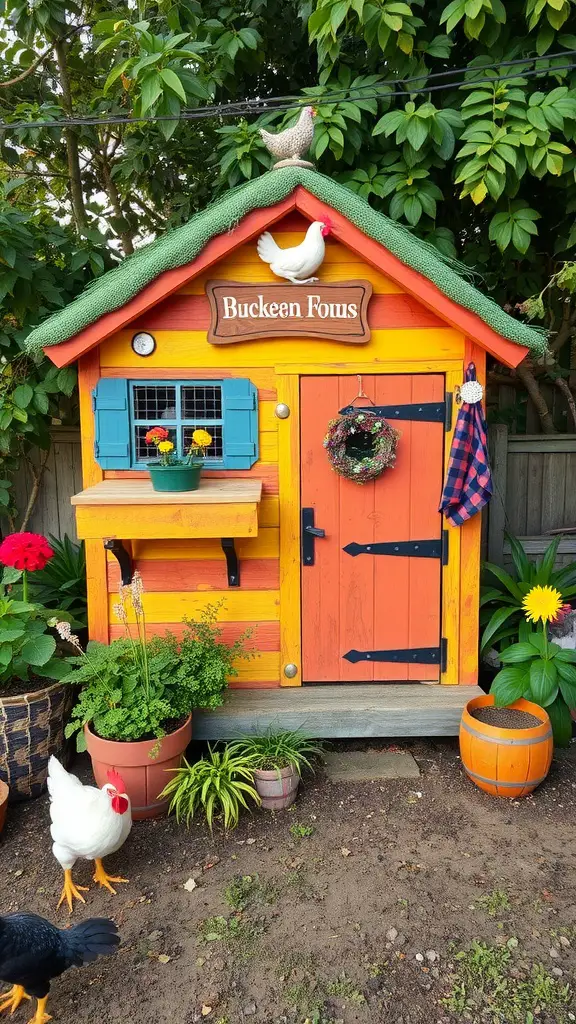
When it comes to decorating your chicken coop, style is just as important as functionality. The coop featured in the image showcases a vibrant mix of colors and charming details that create a welcoming atmosphere. The bright yellow and orange paint not only catches the eye but also adds a cheerful vibe to the backyard.
The inclusion of decorative elements, such as the sign ‘Buckeen Rous,’ gives the coop a personalized touch. This small detail reflects the joy of having chickens while also making the space feel uniquely yours. Adding a fun name to your coop can be a delightful way to express your personality.
Plants and flowers around the coop enhance its appeal. The potted arrangements not only beautify the space but also create a natural environment for your hens. Consider adding petunias or other colorful blooms that can thrive in your area. This not only brings color but can also attract beneficial insects.
Don’t forget about practical decorations! The wreath on the door is an excellent example of how you can combine style with functionality. It’s a simple way to make your coop feel homey while ensuring your birds are comfortable. A cozy and inviting coop can also mean happier chickens.
Finally, consider playful touches like the rooster figurines on the roof. These fun accents can reflect your love for poultry while enhancing the overall look. With a few creative ideas, you can transform a basic chicken coop into a delightful retreat that you and your chickens will love.
Monitoring Chicken Health and Behavior
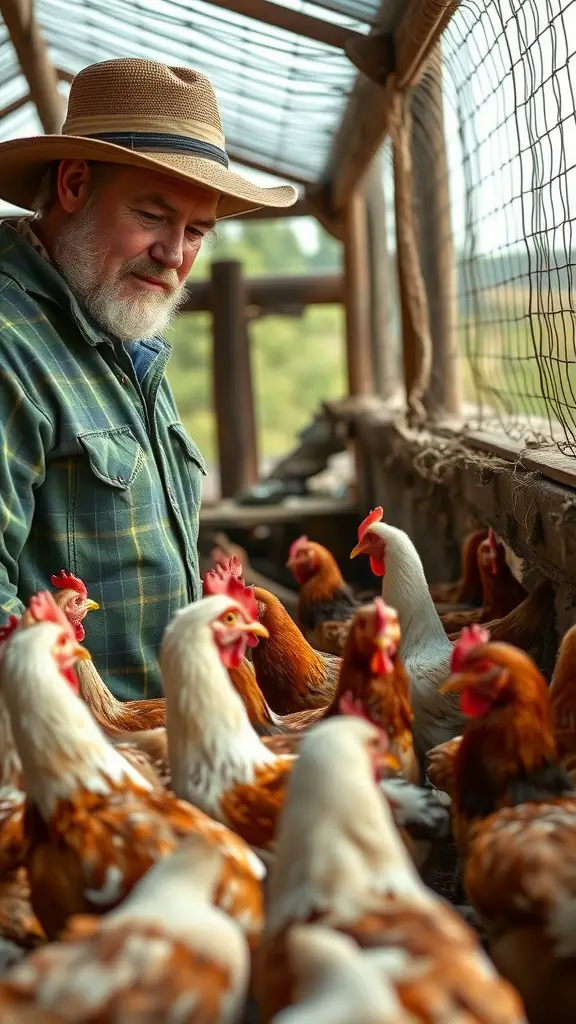
Keeping an eye on your chickens is essential for their well-being. The image shows a dedicated caretaker observing his flock closely. This interaction is crucial for spotting any health issues early on.
Chickens communicate their feelings through body language. If you notice any chicken standing apart from the group, it may be feeling unwell. Regularly checking for signs of illness, such as lethargy or changes in eating habits, helps maintain a healthy environment.
Taking time to interact with the birds also helps you understand their unique personalities. Each chicken may have its own quirks, and recognizing these can alert you to any changes in behavior that could indicate stress or sickness.
Investing in simple monitoring techniques can improve the health of your flock. Keeping a journal of their behavior and health can provide valuable insights over time. This way, you can ensure your chickens are not just laying eggs but thriving in their coop.
Building a Chicken Coop on a Budget

Creating a chicken coop doesn’t have to drain your wallet. This image showcases a cozy chicken coop built from simple materials that are both affordable and effective.
The design features a charming wooden exterior, complete with a sloped roof and secure mesh windows. These elements not only look nice but also provide safety for your feathered friends. By using reclaimed wood or pallets, you can significantly cut down costs.
In the foreground, two chickens appear to enjoy their space, which highlights how a well-built coop can enhance your chickens’ happiness. You don’t need fancy designs to make a comfortable home for your chickens; functionality is key.
Consider using local resources and second-hand materials. A trip to local hardware stores or community markets can yield great finds. With some creativity and a little elbow grease, you can build a chicken coop that works well for you and your budget.
Choosing the Right Chicken Breeds for Your Coop
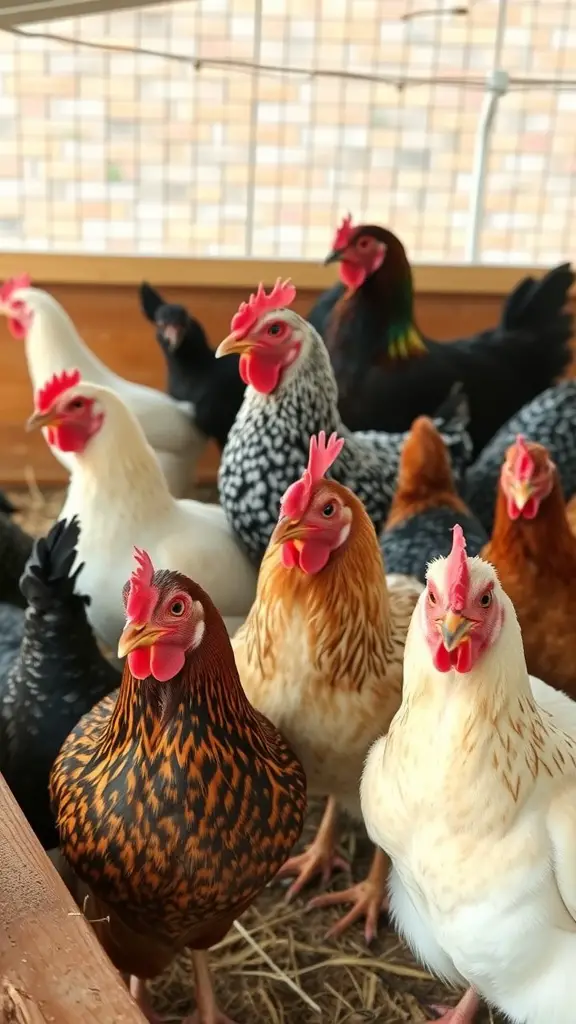
When picking chickens for your coop, it’s important to think about what you want from them. Do you want eggs, meat, or just a few friendly companions? Each breed has different traits that can help you decide.
In the image, you can see a variety of chickens. Some have unique feather patterns and colors, making them not only useful but also beautiful to look at. Breeds like the Rhode Island Red are known for their good egg production, while others like the Orpington are friendly and great with kids.
Consider the climate in your area as well. Some breeds handle cold weather better, while others are better suited for warmer climates. For example, the Leghorn thrives in heat, making it a solid choice for warmer regions.
Don’t forget to think about space and how many chickens your coop can accommodate. A small coop might be ideal for a couple of Bantam breeds, which are smaller and require less room. On the other hand, if you have more space, larger breeds can thrive and provide you with plenty of eggs.
In summary, take your time to research different breeds. Look at their needs, personality, and how they fit into your lifestyle. With the right choice, your chicken coop can be a delightful addition to your home.




